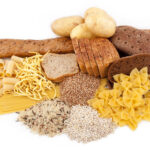Starch is a polysaccharide formed by units of glucose and is the storage form of carbohydrates in plants.
It is synthesized by the most part of vegetable cells and stored especially in seeds, sucha as cereals and legumes, tubers such as potatoes, roots, such as those of carrots, and some fruits, sucha as green banana.
With sucrose and lactose, it is one of the three most common dietary carbohydrates and, among the previous ones, is the main source of carbohydrates in the mediterranean diet pattern.
Contents
Chemical structure of starch
It is present into vegetable cells and contains two types of homopolysaccharides, amylose and amylopectin.
- Amylose is an unbranched homopolysaccharide formed by about 5-600 glucose units, linked by α-(1→4) glycosidic bonds.
It has a helix structure with six glucose units for turn, is soluble in water and places in the core of the starch granules. - Amylopectin represents about 80% of polysaccharides taken up with diet.
It is a branched molecule formed by thousands of glucose units, up to 50000, that, in main chain, are joined by α-(1→4) glycosidic bonds. Approximately every 25-30 glucose units a branch point or lateral chain is present, formed by glucose units as well, joined to the main chain by a α-(1→6) glycosidic bond; glucose units on the lateral chain, from 15 to 25, are linked again by α-(1→4) glycosidic bonds.
The branches prevent the formation of a helical structure while allow the creation of spongy reticular structures.
Classification
Depending on the different velocity and degree of hydrolysis by alpha-amylase, starch can be classified in three classes:
- Rapidly digestible starch
- Slowly digestible starch
- Resistant starch(RS), so called because it opposes to hydrolytic action of α-amylase and is not absorbed in the intestine; nevertheless afterward it may be fermented by colonic micro-flora, acting as dietary fiber.
RS can in turn be classified in:
- Type I RS, corresponding to the not-accessible starches because trapped into cellular matrix by the presence of the intact cellular wall.
It is found in the seeds of cereals and legumes taken up whole. - Type II RS, corresponding to the native starch granules of grains, low susceptible to hydrolysis because of its crystalline nature. These molecules may partially resist to digestion and are found in sour bananas (green) and in containing starch foods cooked in presence of a quantity of water not sufficient for gelatinization.
- Type III RS, representing the fraction of retrogradated starches after cooking. What occurs is the re-aggregation in a crystalline form of the linear portions of amylose (most important) or debranching amylopectin during the cooling of gelatinized starch, process called retrogradation. The degree of retrogradation is directly proportional to the amylose content of the starch itself.
Starch retrogradation is one of the factor that leads to formation of stale bread; it will be sufficient to heat again the bread to lower the crystallization and so revive it; - type IV RS, corresponding to chemically modified starches present in commercialized foods.
The aim of chemical modifications (substitutions or cross-links) is that of obtaining a product stable to refrigeration and freezing; another application is that of conferring to a low caloric content product characteristics of creaminess and palatability typical of fats.
References
- Belitz .H.-D., Grosch W., Schieberle P. “Food Chemistry” 4th ed. Springer, 2009
- Bender D.A. “Benders’ Dictionary of Nutrition and Food Technology”. 8th Edition. Woodhead Publishing. Oxford, 2006
- Englyst H.N., Quigley M.E., Hudson G.J. Definition and measurement of dietary fibre. Eur J Clin Nutr 1995;49:S48-S62
- Osorio-Dıaz P., Bello-Perez L.A., Agama-Acevedo E., Vargas-Torres A., Tovar J., Paredes-Lopez O. In vitro digestibility and resistant starch content of some industrialized commercial beans (Phaseolus vulgaris L.). Food Chem 2002;78:333-337. doi:10.1016/S0308-8146(02)00117-6
- Stipanuk M.H., Caudill M.A. Biochemical, physiological, and molecular aspects of human nutrition. 3rd Edition. Elsevier health sciences, 2012